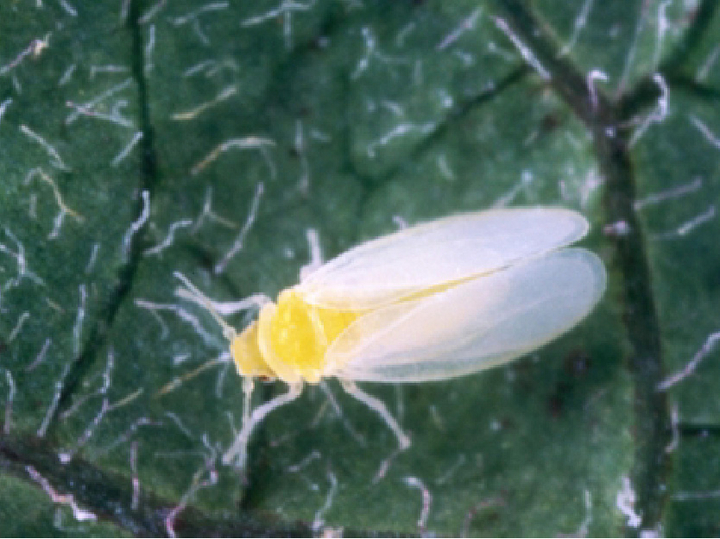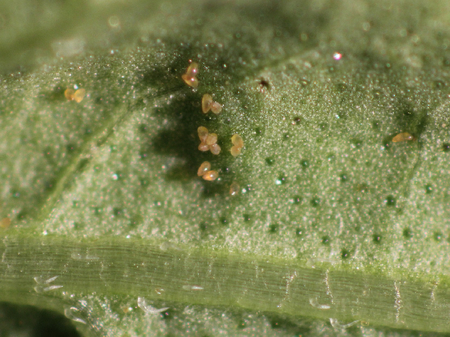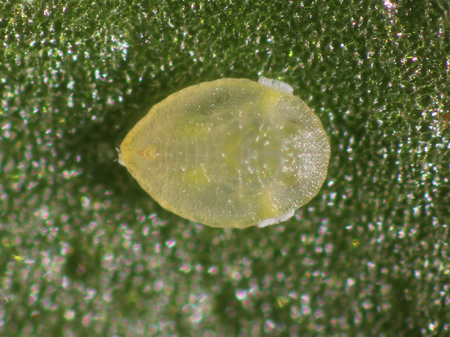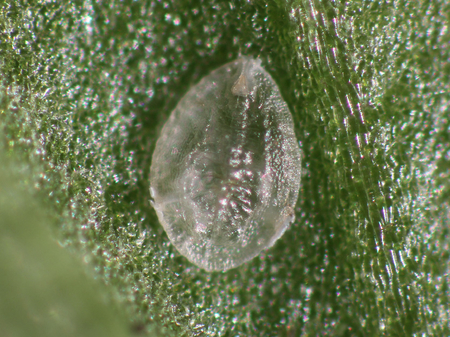Tobacco whitefly
Bemisia tabaci
Profile
The tobacco moth scale insect is a pest that is widespread throughout Europe and has a host plant spectrum of over 1000 plants. In addition to its sucking activity, damage is caused by the transmission of plant viruses. Due to this risk of transmission, non-European populations of the tobacco moth scale are listed as Union quarantine pests (UQS).
Appearance

The tobacco moth scale is very similar in appearance and biology to the closely related greenhouse m oth scale(Trialeurodes vaporariorum). Specialists can distinguish adults by the bristles on their hind legs, while their pseudopupariae can be recognised with some certainty even by laymen, as these are shield-shaped, unlike those of the greenhouse scale insect.
The large white wings are characteristic of the approx. 1 mm large tobacco moth scale insects. The eggs are yellow-green in colour and stalked.
Biology
Adult females can lay up to 300 eggs. Eggs are preferably laid on the underside of the leaves, where the larvae can also be found. Initially the larvae are mobile, but from the second instar onwards they are sessile. After passing through four larval stages, they pupate on the plant. At a temperature of 28 °C, the development period from egg to adult takes about three weeks.
Damage symptoms
Heavily infested plants show yellowing of the leaves and are damaged by the sugary excretions, the so-called honeydew. The honeydew drips onto the underlying leaves and fruit. Black fungi can colonise this shiny coating, resulting in so-called "sooty mould". On the one hand, this soils shoots and fruit, and on the other hand, infected leaves lose assimilation surface. This weakens the plants.
In addition to its sucking activity, the tobacco moth scale damages plants by transmitting more than 400 plant viruses of the genera Begomovirus, Crinivirus, Carlavirus or Ipomovirus.
Host plants
Until recently, the tobacco scale insect was mainly known as a pest of field crops in tropical and subtropical countries, such as cassava, cotton, sweet potatoes, tobacco and tomatoes. However, the host plant spectrum includes over 1000 host plants from over 60 families, including Asteraceae, Brassicaceae, Cucurbitaceae, Convolvulaceae, Euphorbiaceae, Fabaceae, Malvaceae and Solanaceae.
Due to the development of the extremely polyphagous (uses many different plant species for nutrition) subtype B, the tobacco moth scale insect has also become an important pest in glasshouses in many parts of the world, infesting peppers, courgettes, cucumbers, lettuce and tomatoes, hibiscus, gerbera, gloxinia and poinsettia ( Euphorbia pulcherrima), among others.
Spread and transmission
The tobacco moth scale insect can be transmitted in all stages of development with numerous plant species. However, its eggs, larvae and puparia are very often carried with young plants. The international trade in poinsettias probably contributes particularly strongly to the spread of the pest. Adult moth scale insects cannot fly and can be spread over long distances by the wind.
Economic significance
As the tobacco moth scale insect not only causes direct damage to plants through its sucking activity, but is also a vector of various pathogenic plant viruses, it is one of the most important agricultural pests worldwide.
For some years now, enzymatic detection methods have also been used to differentiate between several subspecies of tobacco moth scale insects. The best known of these, subtype B, also known as "silverleaf whitefly"(Bemisia argentifolii), has caused devastating damage to vegetable crops in California, is particularly prolific and highly resistant to insecticidal agents.
Prevention and control
- When purchasing new plants, they should be checked immediately for the presence of whitefly or suspicious symptoms of damage (e.g. yellowish, chlorotic spots, honeydew, sooty mould).
- Monitoring using yellow traps is recommended before and during cultivation, especially for poinsettias and tomatoes.
- Infestation checks should be carried out regularly (especially on older leaves for pseudopuparia) and hygiene measures should be observed, especially at the end of a crop.
- Chemical treatment can be carried out with authorised plant protection products (see list of plant protection products authorised in Austria).
- In organic cultivation, the use of authorised natural antagonists such as the parasitic wasps Encarsia formosa and Eretmocerus eremicus, the predatory mites Amblyseius andersoni and A. swirskii, Amblydromalus limonicus, Transeius montdorensis or Typhlodromips montdorensis, the ladybird beetle Delphastus catalinae, the common field hoverfly Eupeodes corollae, the green lacewing Chrysoperla carnea, the predatory bug Macrolophus pygmaeus or the entomopathogenic fungi Beauveria bassiana or Metarhizium brunneum.
Phytosanitary status
Due to the risk of transmission, non-European populations of the tobacco moth scale insect are listed as Union quarantine pests (UQS) and are therefore subject to legal regulations to prevent the introduction and spread into and within the member states of the EU.
Last updated: 28.10.2024
automatically translated


